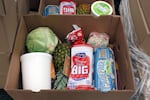After the pandemic ended, the demand for food assistance continued to increase in Oregon, with the need for millions more pounds of produce, pasta and other staples at meal sites and food pantries.
The Oregon Food Bank distributed more than 104 million pounds of food in the fiscal year from July 2022 through June 30, an 11% increase from the prior year. High housing and fuel costs coupled with inflation have contributed to the hunger of tens of thousands of Oregonians.

Many Oregonians continue to face food insecurity.
Oregon Food Bank
U.S. Rep. Andrea Salinas, who represents Oregon’s 6th Congressional District, has noticed the surge in demand. Earlier this month, she introduced a bill that would double the amount of federal funding for the program that keeps Oregon pantries stocked with items.
The Oregon Food Bank, which distributes food to more than 1,400 locations throughout Oregon and southwest Washington, has seen demand grow over the past three years.
Before the pandemic, about 860,000 people annually visited the food bank’s partners in Oregon and southwest Washington, said Morgan Dewey, a spokesperson for the nonprofit food bank. This year, the food bank is on track to serve more than 1 million people, Dewey said.
“We’re just continuing to try to keep up with how much food folks are needing on the ground,” Dewey said.
The needs have increased as extra pandemic-related food benefits from the government have stopped. During the pandemic, most families received 70% more in their monthly allotment of federal food aid, called the Supplemental Nutritional Assistance Program, or SNAP. The extra aid ended in March, with the average household allotment falling from $450 a month to about $300. The state also paid out the last of the pandemic-related extra food benefits for low-income families with young children in October.
“Those supports – when they ended it – really, really put folks in a dire situation,” Dewey said.
The food bank has five warehouses throughout the state that deliver to 21 regional food banks and more than 1,400 other points, including meal sites, delivery programs and pantries. Those sites are critical for rural and frontier areas in Oregon with food insecurity that are not near a large regional pantry, Dewey said.
The operation puts out fresh produce and dairy products, with an eye toward offering nutritional food that aligns with the cultural and ethnic backgrounds of Oregonians.
“Being able to partner with local fishers and ranchers and farmers and other growers really has been advantageous to supplying fresh produce to our communities,” Dewey said. “You know, this is not a warehouse where you walk in and it’s just all Ramen.”
Efforts in Congress
Oregon’s congressional members are looking for ways to keep produce in pantries. Earlier this month, Salinas announced she has introduced a bill to help food banks and local farmers by allowing the U.S. Department of Agriculture to purchase more food directly from producers, including Oregon farmers.
The U.S. Department of Agriculture purchases food products that are sent to the Oregon Food Bank as part of the federal Temporary Assistance for Needy Families program. Essentially, the bill would cut back on red tape and allow the federal government to consider other factors beyond simply the lowest price when considering bids from food producers. This, in turn, would set the stage for smaller family farms to get more contracts that put their products in Oregon pantries.
Salinas, a Democrat, is sponsoring the bill with U.S. Rep. Jimmy Panetta, D-California.
“The pandemic caused higher rates of food insecurity in Oregon and across the country, and food banks have struggled to keep up with the increased demand,” Salinas said in a statement. “The Farmers Feeding America Act will address this problem by providing more funding for the Emergency Food Assistance Program, ensuring our local food banks are fully stocked.”
The bill also would double the federal funding for the program, which was about $20 million for Oregon in 2022.
“With increased funding for The Emergency Food Assistance Program and new resources for food distribution and storage, this legislation will help our communities procure fresh produce and dairy products and address food deserts – especially in under-resourced and remote areas,” Oregon Food Bank President Susannah Morgan said in a statement. “No one should be hungry, and this investment will have a resounding impact for millions of people facing food insecurity.”
For the long term, it’s important to look for ways to address the economic circumstances driving hunger, Dewey said. Those can include unaffordable housing and a lack of access to health care.
“We can serve everyone who is standing in line for a meal or standing in line to get a grocery bag full of food,” Dewey said. “We can serve all those people today, but hunger still won’t go away tomorrow.”
Oregon Capital Chronicle is part of States Newsroom, a network of news bureaus supported by grants and a coalition of donors as a 501(c)(3) public charity. Oregon Capital Chronicle maintains editorial independence. Contact Editor Lynne Terry for questions: info@oregoncapitalchronicle.com. Follow Oregon Capital Chronicle on Facebook and X.